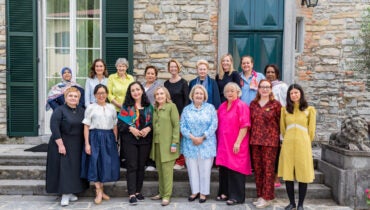On September 1, 2021, GIWPS hosted a panel, “Beyond Geopolitics: The State of Women’s Rights in Iran.” Below are the remarks by Dr. Nina Ansary, author, historian, and women’s rights advocate.
Today gender discrimination permeates almost all areas of law and practice in Iran.
“Women in Iran are caught in a system of gender apartheid…but they refuse to be held back.”
Women in Iran are caught in a system of gender apartheid through legal mandates that relegates them to a subordinate status, depriving them of their basic rights. But, these resilient and couragrous women refuse to be held back and continue to make strides despite the barriers.
Among their countless accomplishments, Iraninan women continue to outnumber men in higher education, comprising 60 percent of all university graduates. They have initiated groundbreaking campaigns as well as a grassroots women’s rights movement fueled by women from all walks of life. Adding to this is a generation of women distinguished for a myriad of outstanding accomplishments in practically every field, from award-winning authors, architects, journalists, documentary filmmakers, scientists, Olympic athletes, and even the first woman to ever win the Fields Medal—the Nobel Prize of Mathematics—the late Professor Maryam Mirzakhani.
As part of today’s conversation, the distinguished panelists and speakers have highlighted and enumerated the challenges in relation to the current circumstances and the crucial importance to center Iranian women’s rights and the barriers they face to advancing progress within the global arena.
The recent election of Iran’s hardline President Ebrahim Raissi, and his record of egregious human rights violations, compounded by a Supreme Leader who believes “gender equality is one of the biggest misconceptions of Western thought,” brings forth the unfortunate reality that in all likelihood women in Iran will undoubtedly be faced with even more daunting challenges in the years ahead. As we are all aware, Iran’s former President Hassan Rouhani failed to deliver on many of his campaign promises, including economic improvement, a more tolerant society, more social freedoms, and increased rights for women. In fact, far from delivering, Mr. Rouhani—a so-called moderate—moved closer to the policies of the judiciary and the hardline establishment.
“If, in fact, the international community wishes to negotiate and enter into ‘deals’ with Iran, then it is critical to ensure that women’s rights are properly included.”
With respect to the current circumstances and a road inevitably paved with tremendous obstacles, a crucial component in supporting women’s rights in Iran centers on the solidarity of the international community. Women and human rights organizations, activists, media, publications, and the Iranian diaspora can actively engage by placing women’s rights at the center of the global agenda. This includes raising awareness by speaking openly and persistently against injustices and violations in Iran, especially given that in recent years the regime has intensified its crackdown, suppressing growing domestic discontent and dissent by putting down widespread peaceful protests through coercive measures.
Where the media and the political landscape are concerned, there is a tendency to focus on issues outside the purview of rights violations. Oftentimes topics such as the Iran Nuclear Deal take center stage, while issues on women’s rights remain largely in the shadows. Meaning that if, in fact, the international community wishes to negotiate and enter into “deals” with Iran, then it is critical to ensure that women’s rights are properly included. Furthermore, the argument typically used that inclusion of women’s rights and human rights could potentially undermine the negotiation process is in reality an argument that is fundamentally flawed. I am well aware of the intricacies of formulating a comprehensive agreement linked to women’s rights; however, by addressing this crucial topic, the international community not only conveys the importance it attaches to the manner in which Iran treats its own citizens but also the respect for international human rights standards as well as recognition of human dignity. With this in mind, there are potential avenues to merge women’s rights with strategic priorities. As an example, the Reagan administration pushed for better treatment of Russian citizens as part of negotiating arms control with Moscow. Essentially, this requires a foreign policy approach that includes women’s rights as a major pillar and the bridge between global security issues and the fate and aspiration of the Iranian people.
“It is important to remember that throughout the centuries Iranian women have fought with tenacity to determine their fate.”
In terms of women’s rights and the Iranian diaspora, oftentimes there is a tendency to fragment our battles and focus on issues that set us apart rather than those that unite us—that being the bigger picture and the overall objective—which, simply put, is to bring about meaningful change, and with that, the hope of restoring Iran to its former glory.

There are few countries in the world in which women have experienced more sudden, shocking and drastic overnight changes than Iran.
From a historical perspective, it is important to remember that throughout the centuries Iranian women have fought with tenacity to determine their fate. And while there were periods in Iran’s history when women were relatively free to forge their own path, such moments in history have been few and far between. Prior to the 7th century Arab invasion and subsequent conversion to Islam, Iran was in many ways more progressive when it came to women than some 21st century societies. Owed in large part to Zoroastrianism, the dominant religion at the time, women were permitted to assume leadership roles and influential positions in various endeavors, including serving as high ranking commanders in the military. Women also ruled as queens—albeit briefly—over the vast Persian Empire. In the aftermath of Islam and centuries of patriarchal decrees, the Pahlavi era witnessed the emancipation of the Iranian woman with expanded rights and opportunities including the enfranchisement of the female population at large. But for most of history, women have had to contend with an inferior status—a defect that continues to contaminate the soul of Iran.

However, despite enormous challenges, Iranian women have had a long and critical history of activism, meaning that what we are witnessing today is not simply a post-revolutionary phenomenon. The fact is, Iranian women can play a pivotal role, and have done so historically. In the mid-19th century, for example, despite diminished rights embedded in policy and law, Iranian women took it upon themselves to protest, and played a critical role in the defeat of the Tobacco Concession granted to Great Britain. And in the early 20th century, women took part in the Constitutional Revolution of 1906 which sought to break Iran free from foreign ownership of its resources.
In the mid-19th century, when women in many parts of the world were advocating for their rights, Qurrat al- Ayn aka Tahirh (1917-1852), Iran’s first suffrage martyr, courageously defied conventional norms by appearing unveiled in public. Her final words prior to being strangled and thrown down a garden well proved prophetic: “You can kill me as soon as you like, but you cannot stop the emancipation of women.” In the 21st century, Tahirih’s spirit echoes in countless women in Iran—women like prominent human rights attorney Nasrin Sotoudeh, was sentenced to 38 years and 148 lashes. Her crime: defending women protesting Iran’s compulsory veiling laws. In fact, Ms. Sotoudeh’s sentencing set a new tone for judicial repression of women’s rights. In a letter recently written from prison to prosecutor Abbas Jaffari, Nasrin wrote: “Tell your judges to issue triple-digit sentences, but it won’t make a difference because women have decided to rule over their own bodies.” And in a letter written to her children from prison she wrote: “I want you to know that as a woman, I am proud of the heavy sentence rendered against me and honored to have defended many human rights defenders…. I know you need water, food, housing, a family, parents, and visits with your mother. However, just as much you need freedom, social security, the rule of law and justice.”
A recording of the full event, “Iranian Women on the Frontlines: Strategies for Change,” is available on Facebook and YouTube.


